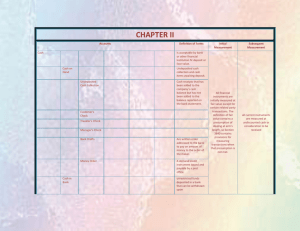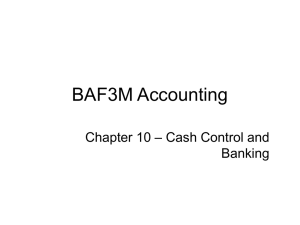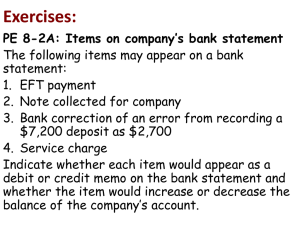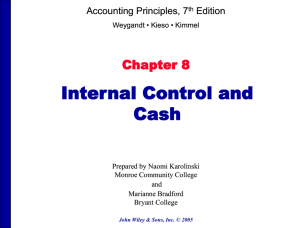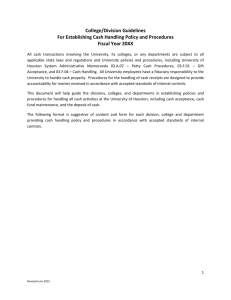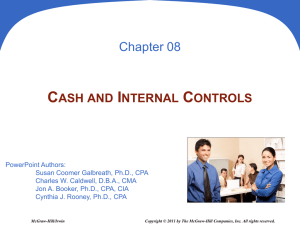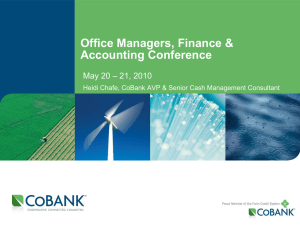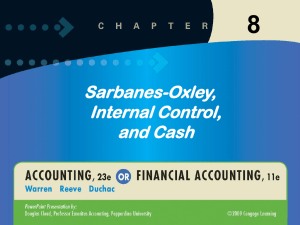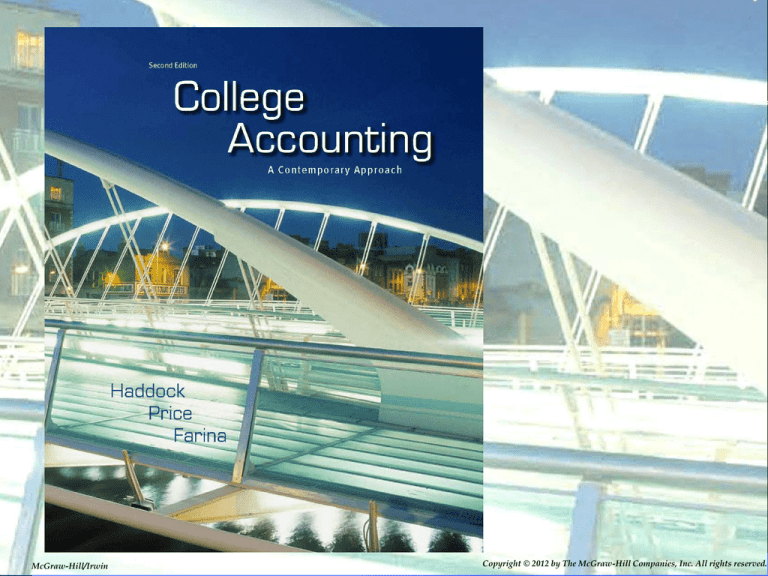
McGraw-Hill/Irwin
1-1
Copyright © 2012 by The McGraw-Hill Companies, Inc. All rights reserved.
9–1
Chapter
9
Cash
Section 1: Cash Receipts
Section Objective
1.
Account for cash short or over
9–2
The type of cash receipts depends on
the nature of the business.
Supermarkets receive checks as well as
currency and coins.
Department stores receive checks in the
mail from charge account customers.
Wholesalers usually receive cash in the
form of checks.
9–3
Objective 1
Account for Cash Short or Over
Occasionally errors occur when making change.
The cash in the cash register is either more or less
than the cash listed on the cash register tape.
When cash receipts are more than the sales as per
the cash register tape, cash is over.
When cash receipts are less than the sales as per the
cash register tape, cash is short.
9–4
Account for Cash Short or Over
Cash tends to be short more often than over because customers
are more likely to notice and complain if they receive too little
change.
Cash short or over amounts are recorded in the Cash Short or
Over account.
A credit balance in the account is an overage, that is treated as
revenue.
Similarly if there is a debit balance in the account, there is a
shortage ( treated as expense).
9–5
Account for Cash Short or Over
• Royal Jewelry Store, a retail business, keeps a $200 change fund in
its cash register.
• Royal Jewelry Store started business on September 29.
• The cash sales as per the cash register tape on September 29 were
$2,200.
• The cash count was $2,397. The cash register was short by $3,
calculated as follows.
Cash count
Less change fund
Bank deposit
Sales per cash register tape
Amount short
$2,397
200
$2,197
2,200
($3)
9–6
Account for Cash Short or Over
Journal entry to record the sales and cash shortage
9–7
Account for Cash Short or Over
• The cash sales as per the cash register tape on September 30
were $2,100.
• The cash count was $2,301.
• The cash register was over by $1, calculated as follows.
Cash count
Less change fund
Bank deposit
Sales per cash register tape
Amount over
$2,301
200
$2,101
2,100
$1
9–8
Account for Cash Short or Over
Journal entry to record the sales and cash overage
9–9
Cash Received on Account
Generally a business makes sales on account and
bills customers once after a specified period (say, a
month.)
It sends a statement of account that shows the
transactions during the month and the balance
owed.
Checks from credit customers are journalized and
posted, and then the checks are deposited in the
bank.
9–10
Promissory Note
A promissory note is a written promise to pay a
specified amount of money on a certain date.
Promissory notes are specified interest bearing
notes.
They are used by businesses to extent credit.
Also used to replace an accounts receivable
balance when an account is overdue.
9–11
Collection of a Promissory Note and Interest
On July 31 Maxx-Out Sporting Goods accepted
a six-month promissory note from Stacee
Fairley, who owed $800 on account.
9–12
On July 31, Maxx-Out Sporting Goods recorded a
general journal entry to increase notes receivable and
to decrease accounts receivable for $800.
The asset account, Notes Receivable, was debited. The
Accounts Receivable account was credited.
9–13
Amount owed
=
$800
Interest rate
=
9% per year
Rate for six-month period
=
=
(9%) ÷ 2
4.5%
Interest amount
=
=
$800 x 4.5%
$36
Total amount with interest
=
=
$800 + $36
$836
9–14
Chapter
9
Cash
Section 2: Petty Cash and Internal
Controls for Cash
Section Objectives
2.
Demonstrate a knowledge of
procedures for a petty cash fund
3.
Demonstrate a knowledge of internal
control routines for cash
9–15
Demonstrate a knowledge of procedures
Objective 2
for a petty cash fund
9–16
Establishing the fund
The amount of petty cash fund depends upon the need
of the business.
The cashier is responsible for the petty cash.
The establishment of petty cash fund should be recorded
as:
9–17
The Petty Cash Analysis Sheet
Used to record transactions involving petty cash.
Contains two major columns: Receipts and
Payments.
Contains special columns such as: Supplies,
Delivery Expense, and Miscellaneous Expense.
Other Accounts Debit column for entries that do
not fit in a special column.
9–18
Replenishing the Fund
• The total vouchers plus the cash on hand should
always be equal to the amount of the fund.
• Replenish the petty cash fund at the end of each
month or sooner if the fund is low.
• A check is written to restore the petty cash fund
to its original balance.
• A journal entry is prepared to record the check.
9–19
Total Payment equal Total of
individual expense accounts
Replenish fund equals the Total
Payments
9–20
The following internal control procedures apply to
petty cash:
1. Use the petty cash fund only for small payments that cannot
conveniently be made by check.
2. Limit the amount set aside for petty cash to the approximate
amount needed to cover one month's payments from the
fund.
3. Write petty cash fund checks to the person in charge of the
fund, not to the order of "Cash."
9–21
4.
Assign one person to control the petty cash fund. This
person has sole control of the money and is the only one
authorized to make payments from the fund.
5.
Keep petty cash in a safe, a locked cash box, or a locked
drawer.
6.
Obtain a petty cash voucher for each payment. The voucher
should be signed by the person who receives the money and
should show the payment details. This provides an audit trail
for the fund.
9–22
Objective 3
Demonstrate a knowledge of internal
control routines for cash
Essential Cash Receipt Controls
1.
Have only designated employees receive and handle
cash. In some businesses employees handling cash
are bonded.
2.
Keep cash receipts in a cash register, a locked cash
drawer, or a safe while they are on the premises.
3.
Make a record of all cash receipts as the funds come
into the business.
9–23
4.
Check the funds to be deposited against the record
made when the cash was received.
5.
Deposit cash receipts in the bank promptly. Deposit
the funds intact.
6.
Enter cash receipt transactions in the accounting
records promptly.
7.
Have the monthly bank statement sent to and
reconciled by someone other than the employees who
handle, record, and deposit the funds.
9–24
Advantage of handling and recording cash receipts
• Funds reach the bank sooner.
• Cash receipts are not kept on the premises for more than a
short time.
• Funds are safer and are readily available for paying bills
owed by the firm.
9–25
Essential Cash Payment Controls
1.
Make all payments by check except for payments from
special purpose cash funds such as a petty cash fund.
2.
Issue checks only with an approved bill, invoice, or other
document that describes the reason for the payment.
3.
Have only designated personnel approve bills and
invoices.
4.
Have checks prepared and recorded in the checkbook or
check register by someone other than the person who
approves the payments.
9–26
5.
Have still another person sign and mail the checks to
creditors.
6.
Use prenumbered check forms.
7.
During the bank reconciliation process, compare the canceled
checks to the checkbook or check register.
8.
Enter promptly in the accounting records all cash payment
transactions.
9–27
Chapter
9
Cash
Section 3: Banking Procedures
Section Objectives
4.
Write a check, endorse checks, prepare a bank deposit
slip, and maintain a checkbook balance
5.
Reconcile the monthly bank statement
6.
Record any adjusting entries required from the bank
reconciliation
7.
Understand how businesses use online banking to
manage cash activities
9–28
Objective 4
Write a check, endorse checks,
prepare a bank deposit slip, and
maintain a checkbook balance
9–29
Checks and Check Stubs
This check is a negotiable financial instrument
9–30
Before writing the check, complete the check stub.
The check stub shows:
Balance brought forward: $12,025.50
Check amount: $1,500
Balance: $10,525.50
9–31
Endorsements
Full Endorsement
PAY TO THE ORDER OF
FIRST TEXAS NATIONAL BANK
Maxx-Out Sporting Goods
38-14-98867
Blank Endorsement
Restrictive Endorsement
PAY TO THE ORDER OF
Maxx Ferraro
FIRST TEXAS NATIONAL BANK
FOR DEPOSIT ONLY
38-14-98867
Maxx-Out Sporting Goods
38-14-98867
9–32
Preparing the Deposit Slip
9–33
Objective 5 Reconcile the monthly bank statement
The difference between the bank balance and the book
balance is due to errors.
Errors made by banks
Errors made by businesses
Arithmetic errors
Arithmetic errors
Giving credit to the wrong
depositor
Not recording a check or
deposit
Charging a check against
the wrong account
Recording a check or
deposit for the wrong amount
Many banks require that errors in the bank statement be reported
within a short period of time, usually 10 days.
9–34
Other than errors, there are four reasons why the book
balance of cash may not agree with the balance on the
bank statement.
1. Outstanding checks.
2. Deposit in transit.
3. Service charges and other deductions not recorded in
the business records.
4. Deposits, such as the collection of promissory notes,
not recorded in the business records.
9–35
Format of a bank reconciliation statement
First Section
Bank statement balance
Second Section
=
Book balance
+
deposits in transit
+
deposits not recorded
–
outstanding checks
–
deductions
+ or –
+ or –
bank errors
Adjusted bank balance
=
errors in books
Adjusted book balance
9–36
Steps to prepare the bank reconciliation statement:
First Section
1.
Enter the balance on the bank statement.
2.
Compare the deposits in the checkbook with the deposits
on the bank statement.
3.
List the outstanding checks.
4.
List any bank errors.
5.
Compute the adjusted bank balance.
9–37
Steps to prepare the bank reconciliation statement:
Second Section
1.
Enter the balance in books from the Cash account.
2.
Record any deposits made by the bank that have not been
recorded in the accounting records.
3.
Record deductions made by the bank.
4.
Record any errors in the accounting records that were
discovered during the reconciliation process.
5.
Compute the adjusted book balance.
9–38
Record any adjusting entries required
Objective 6
from the bank reconciliation
For Maxx-Out Sporting Goods, two entries must be made.
GENERAL JOURNAL
DATE
DESCRIPTION
Jan 31
1.
2.
Accts. Rec./David Newhouse
Bank Fees Expense
Cash
To record NSF check and service charge
POST.
REF.
PAGE
DEBIT
17
CREDIT
525.00
25.00
550.00
The first entry is for the NSF check from David Newhouse, a
credit customer.
The second entry is for the bank service charge.
The effect of the two items is a decrease in the Cash account balance.
9–39
Understand how businesses can use
Objective 7
online banking to manage cash activities
Using On-line Banking
Many businesses now manage many
transactions online:
Electronic Funds Transfers – EFT’s
Payments to government agencies
Payments from customers
Payments to vendors
9–40
Thank You
for using
College Accounting
A Contemporary Approach, 2nd Edition
Haddock • Price • Farina
9–41

